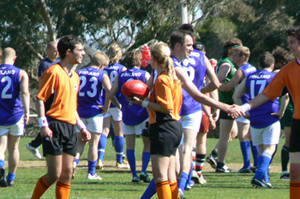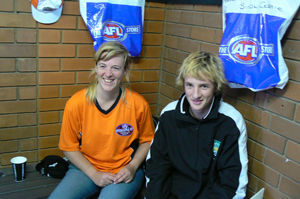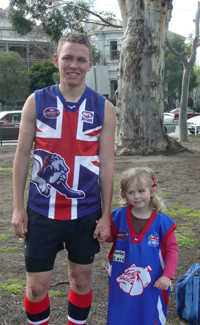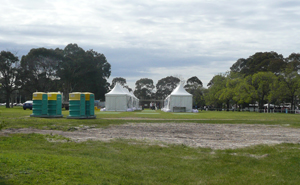Outside the Boundary Line
- Tuesday, September 23 2008 @ 01:43 pm ACST
- Contributed by: Stephen Alomes
- Views: 8,811

The International Cup was a great success because of the many people who made it happen, from the AFL Development staff and a range of other people, mostly volunteers including the umpires, trainers and physios, the ground announcer and the alternative as well as official AFL IC 08 media. It also had its scenes, its images, its moments off the field as well as on – that’s footy.
The men and women in orange
The umpires, co-ordinated by Jim Cahill, came from suburban and country leagues including central whistleblowers, umpires Kylie from Waverley and Simon from the Southern Football League and adding an international touch, French boundary umpire, Loïc, known as ‘M’sieur Marty’ by his fellow umpires. He was interviewed in French and English in the umpires’ change rooms and had also keenly followed the story of the ‘Coupe de France’ footy tournament played in Paris in June.
 | 
| |
| M. Marty le boundary, and central umpire Kylie. | Umpires can laugh... Kylie and Simon after Ireland vs Finland |
On the field, the umpires also had language interpretation problems. Not only are those unclear areas (how long is a mark? when does a firm tackle from behind become either holding the ball or a push in the back?) but other linguistic problems. The umpires sometimes depended on team interpreters to explain to those still learning them or still learning English, or bent the rules when dealing with novices: the full back, in a much weaker team which was way behind, who was given another kick after a behind when in error he handballed from the square.
The Cup’s tradition of three cheers and shaking hands with the umpies gave the men and women in orange, without whom there would have been no Cup, due recognition.
The Eagle Rock view from above…
The ground announcer was perched not in an eagle’s eyrie but on a tray a couple of metres up. He worked hard at observing who was in the play and had some good lines, including ‘close encounters of the multicultural kind’, Rod Grljusich has a background as a C&W singer. He called the American Nationals at Atlanta and was headhunted by the ever innovative Kevin Sheedy. He sees himself as a ‘colour caller’. While to some people he used too many images – had he called some Bingo too? – his commentary on the matches was informed and observant and useful for those (ie most people) who didn't know many of the players from the competing teams.
He also did interesting interviews with Australian Football’s visionaries including Ron Barassi and Brian Dixon, both with a longstanding commitment to internationalising the game. ‘Dicko’, the former Melbourne wingman and Victorian sports minister, remarked that he had first played overseas when Melbourne played Geelong in New Zealand, Hawaii and San Francisco in the early 1960s.
Many of the umpires and trainers, including medical coordinator Garry Bilson had been at all three of the International Cups. For most of them it meant giving up work time and working hard as volunteers. Some suited up both at Royal Park and in Warrnambool.
Where does it feel sore?
The trainers also had to interpret as they provided key support in English, sign language and beyond, delivered with communicative and restorative hands. Sometimes they had to wait for the interpreter or use sign language to get the message across. They included Marlene Kirk from Tarwin Lower in South Gippsland and Andrew Bilson from Gisborne and Glenys from the Brisbane Lions’ Melbourne trainers. Marlene Kirk remarked on the improved standard of play compared to the previous two International Cups at which she had also volunteered. She was impressed by the ‘really passionate’ overseas players, who confirmed her view that ‘it is the best game in the world’.

|
| Marlene Kirk and Andrew Bilson awaiting the call. |
Clear designs across the waters
There were other key people such as the Mount Clear Primary School Grade 5/6 students from Ballarat, with their grade teacher Mrs Scarlett, who were barracking for China. Over a 12 month project with the Tianjin Demons they had gone on to contribute designs leading to the final design of the Chinese guernsey.

|
| The view from Mount Clear - Go China! |
Nutritious food… footy marches on coffee… and pies
The ubiquitous fast food van satisfied the practical needs of many – although not the dietary requirements of those with different beliefs, which were looked after at the opening night reception at the MCG.
Even on a sunny day, more important for many people was that Melbourne and Victorian necessity, the coffee machine. It helped, whether you are a traditionalist and wanted cappuccino the Australian way with a sprinkle of chocolate, or were more fundamental, with a need for an espresso, or even more trendy wanting a macchiato or a latte before you played or before you watched.
And there were no caffeine testers at the grounds, or so it seemed.
Kenny, where are you?
When you are not playing at an established and elaborate stadium with crowd food and drink facilities, media rooms, and every facility, some of the infrastructure has to be brought in.
A brilliant array of peaked tents might have suggested that the IC was linked to a medieval jousting tournament with chivalrous knights on horse. It did give teams a place to gather before they used their rotation in the sheds before the match.
The beautiful background of the gum trees of Royal Park and the urban scene of the passing Upfield suburban train also added a touch that was both Australian and Melbourne, although some felt that the parking officers booking the cars parked on the grass near the trees could have been left out of the script for the Cup.
Everyone was there except that great Australian ambassador, Kenny, plumber to the nation and the world as in the film and TV series of the same name. However, there were Portaloos for those who had been drinking their sports drinks, their coffees, their soft drinks or something stronger.
Media ‘Centres’
 | While the regular reporting of the Cup happened within the West Brunswick FC rooms, the centre of IC administration as well, on the Friday night at the ‘G’ there were also Brett Northey and Troy Thompson, as part of the media, reporting the New Guinea victory over New Zealand from the Media Centre in the Olympic Stand, a more elaborate world of laptops and party pies. |
The Future of the Game
The 21st century future of the game was present at the International Cup too, in such examples as young Neave Swift, three-year-old sister of the British Bulldog rover Ashley Swift, and the son of one of the Kiwi players proudly wearing his father’s runner-up medal.
 | 
|
| Ashley Swift with sister Neave. | Toby wears his father Paul's medal and enjoys the footy. |




 RSS news
RSS news Twitter
Twitter Facebook
Facebook